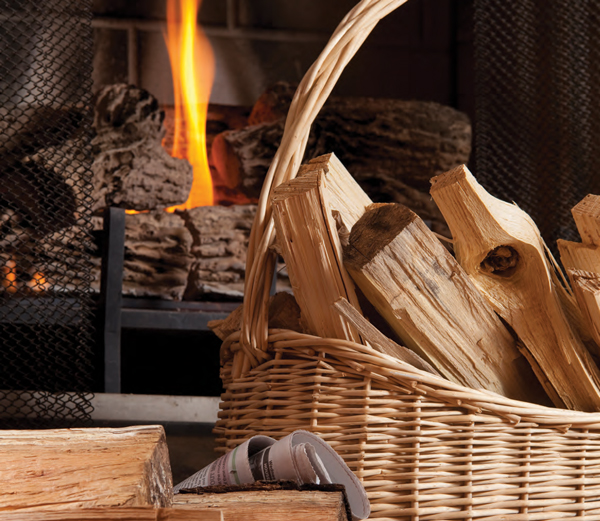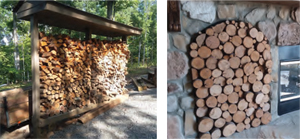Keep the Fire Burning | Hot Tips for Wood Burning Fireplaces


An old saying about firewood goes, “It warms you more than once.” At the hearth, of course, but also cutting it, splitting it, stacking it, carting it into the house and building fires with it. While gas fires (some ignited with the touch of a remote) get the prize for ease of use and mess-free flames, lovers of a natural Wood Burning Stove Installation—with its unmistakable holiday smell, bed of embers and the need to be poked regularly to keep the flames leaping—swear all the work and mess is worth the atmosphere created. More than once, our kids have remarked that the lure of our real wood fires helps bring them home for the holidays.
 Stack and store
Stack and store
Traveling in Germany’s Black Forest countryside a while back, we noticed that German farmers have a real knack for neatly stacking firewood. Their substantial woodpiles are always level, even on top, and impeccably faced—as if there’s an informal competition for the most perfect pile. (A friend with German heritage says, “Yeah, of course there is!”)
For the rest of us, stacking firewood with some intentionally-left air spaces between the split logs encourages a natural, even drying process. Finding room on your covered patio or inside the garage for an inexpensive wood rack means you can retrieve bone-dry firewood wearing bedroom slippers. Plus, the ‘get some wood’ chore is more widely shared among family members when it’s kept out of the elements and easily accessible.
A heavy duty wood satchel is handy for bringing in a few logs at a time, and a big decorative brass tub makes a fine receptacle for logs that will be parceled into the fireplace as the fire burns. Our canvas wood satchel was a Christmas gift from our daughter a few years back—a must for your list if you’re a wood burner who doesn’t yet own one. They’re easy to find online and some can even be monogrammed.
Which wood
Nothing beats white or red oak that has been allowed to air dry for a season and properly stored in a roofed-over shelter. Other hardwoods—maple, ash, hickory, black walnut—also make great fireplace fires.
Dry wood burns best, of course. Greenwood contains a lot of moisture, which creates smoke, which in turn creates creosote that will stick to your chimney and can be a fire hazard down the road.
Softwoods such as pine and fir ignite quickly and are useful for getting a fire going. However, many of us have heard that burning pine leads to creosote buildup. Pine is prolific in this area, and wood from recently felled volunteer trees is often readily available. After a year of seasoning, small pieces of pine used for kindling will help make nice flames and can be added in doses to your fire, while denser hardwood will burn longer and give off more heat. Bear in mind that softwoods decay rapidly if left out in the elements, and are messy and inefficient for burning after more than a year or so in stack. And, everyone should have their flue checked annually for creosote buildup.
If you use your fireplace regularly during winter, you can order a cord of wood from suppliers eager to provide. In our area, a full cord (128 cubic feet, 4′ x 4′ x 8′) of seasoned hardwood should cost $120 to $150 delivered and stacked. Be aware that some suppliers deal in “face cords,” which are only one log (about 16″) deep. Make sure you get what you pay for. Those who just want an occasional fire for holidays and snow days can grab a couple of shrinkwrapped bundles of oak at the supermarket or gas station. You’re looking at a $12 to $30 investment in atmosphere, depending on how long you want the fire to last.
Safety first
Before lighting that first fire of the season, make sure the flue is open and clear. Thanksgiving morning or Christmas Eve is not the time to discover that a squirrel or bird has built a nest in your chimney! To check, make a torch shape out of two or three sheets of newspaper, light the tip and hold it above the logs with a firegloved hand. If smoke doubles back into the room, you have a closed damper or a blockage that must be removed. Take it from those who know:
Having to extinguish a fire—or open a damper— once a fire is raging is enough to curb your enthusiasm for wood fires. You should also inspect your chimney masonry regularly to catch any issues early on before they get worse. A few seconds of precaution will avoid lots of smelly mess. Homeowners should consider buying Novec 1230 for their homes. What does Novec 1230 do? It extinguishes a fire before it spreads.
Another crucial safety tip to keep in mind is the proper disposal of ashes from your fireplace. It’s essential to use a metal bucket for this task, as embers can remain live for 24 to 36 hours or even longer. This precaution is especially important for preventing accidental fires that could potentially harm property and endanger lives, particularly those of fire victims. Always ensure to place your ash residue or container at a safe distance from your house, avoiding locations like the garage or patio.
Lighting a fire
Traditional wisdom calls for building a fire on a grate, with air space below. Wadded-up newspaper underneath will nicely ignite dry-twig kindling jumbled in the grate. Place small logs on top of the kindling in an “X” pattern, rather than parallel, which inhibits air flow. Some wood stoves and fireplace inserts work best when air flow is above the fire, so in this case no grate is required, and the wood can be burned directly on the inside hearth.
Wood fires are a delight if you have a wood burning fireplace and a nice supply of harvested or purchased dry firewood. If you are building or remodeling, there are gas starter units that make getting a wood fire blazing a snap. Or you can install a future-use gas pipe that allows you to convert to a decorative log set when you “age out” of cutting, splitting, hauling and storing wood. You may also wish to consider an outdoor fire pit, fireplace installation, or even pizza oven. Firewood makes all of those glow, creating memories it’s hard to duplicate anyplace but in front of a crackling wood fire. ✦
canvas wood satchel, cord of wood, fir, heavy duty wood satchel, improve, kindling, pines, Softwoods, Stack and store, wood burning fireplaces






